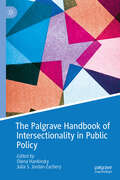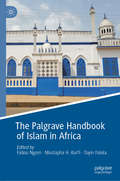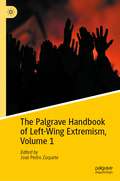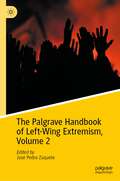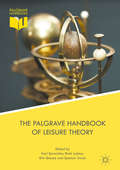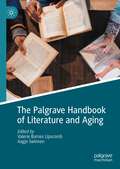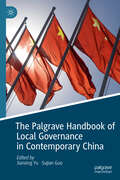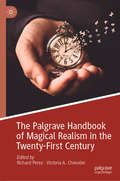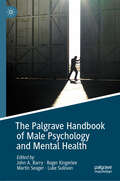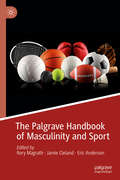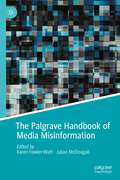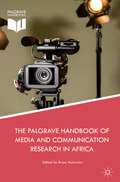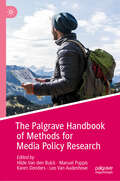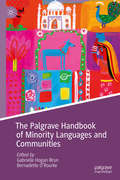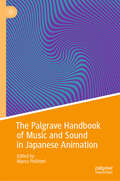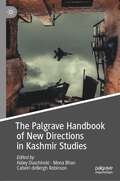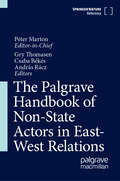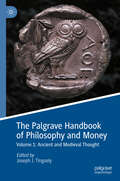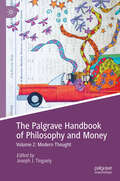- Table View
- List View
The Palgrave Handbook of International Labour Migration
by Marion Panizzon Gottfried Z�rcher Elisa Fornal�This Handbook focuses on the complexity surrounding the interaction between trade, labour mobility and development, taking into consideration social, economic and human rights implications, and identifies mechanisms for lawful movements across borders and their practical implementation.
The Palgrave Handbook of Intersectionality in Public Policy (The Politics of Intersectionality)
by Olena Hankivsky Julia S. Jordan-ZacheryGrounded in black feminist scholarship and activism and formally coined in 1989 by black legal scholar Kimberlé Williams Crenshaw, intersectionality has garnered significant attention in the field of public policy and other disciplines/fields of study. The potential of intersectionality, however, has not been fully realized in policy, largely due to the challenges of operationalization. Recently some scholars and activists began to advance conceptual clarity and guidance for intersectionality policy applications; yet a pressing need remains for knowledge development and exchange in relation to empirical work that demonstrates how intersectionality improves public policy. This handbook fills this void by highlighting the key challenges, possibilities and critiques of intersectionality-informed approaches in public policy. It brings together international scholars across a variety of policy sectors and disciplines to consider the state of intersectionality in policy research and analysis. Importantly, it offers a global perspective on the added value and “how-to” of intersectionality-informed policy approaches that aim to advance equity and social justice.
The Palgrave Handbook of Islam in Africa
by Toyin Falola Fallou Ngom Mustapha H. KurfiThis handbook generates new insights that enrich our understanding of the history of Islam in Africa and the diverse experiences and expressions of the faith on the continent. The chapters in the volume cover key themes that reflect the preoccupations and realities of many African Muslims. They provide readers access to a comprehensive treatment of the past and current traditions of Muslims in Africa, offering insights on different forms of Islamization that have taken place in several regions, local responses to Islamization, Islam in colonial and post-colonial Africa, and the varied forms of Jihād movements that have occurred on the continent. The handbook provides updated knowledge on various social, cultural, linguistic, political, artistic, educational, and intellectual aspects of the encounter between Islam and African societies reflected in the lived experiences of African Muslims and the corpus of African Islamic texts.
The Palgrave Handbook of Language and Crisis Communication in Sub-Saharan Africa
by Hugh Mangeya Isaac Mhute Ernest JakazaThis handbook provides a detailed and sustained examination of the scope, purpose and practical application of crisis and disaster management communication in this critical region of the African continent, sub-Saharan Africa (SSA). The volume lays the foundation that enables a nuanced appreciation of two significant issues. The first pertains to SSA’s vulnerability to both natural and man-made phenomena. Secondly, it argues that communication plays a critical role in so far as the identification, social construction, raising awareness, preparation, mitigation and eradication of crises and disasters in the region. Communication plays a critical role in potentially reducing the impacts of crises and disasters before their occurrence. This handbook is a key resource for academics, students and practitioners in areas such as political communication, media communication, language and communication, brand communication, social/digital media communication, and crisis communication, among others.
The Palgrave Handbook of Left-Wing Extremism, Volume 1
by José Pedro ZúqueteThis handbook provides a broad overview of left-wing extremism and its associated key issues and themes. It breaks new ground by assembling in a single volume a comparative analysis of the phenomenon that is both multidimensional and multidisciplinary. Gathering a wide range of influential scholars who have worked at length in the field of extremism studies from different perspectives, backgrounds, and geographical settings, the Palgrave Handbook of Left-Wing Extremism presents an array of thought-provoking and innovative as well as informative analyses and discussions – both historical and contemporary - about the phenomenon of left-wing extremism and of how researchers conceive of and approach it in their study. The Handbook is designed to be, for the foreseeable future, the reference work for all students, researchers, and general readers interested in achieving a comprehensive understanding of left-wing extremism in all its manifestations, subtleties, and dynamics, and both its current and its potential directions.
The Palgrave Handbook of Left-Wing Extremism, Volume 2
by José Pedro ZúqueteThis handbook provides a broad overview of left-wing extremism and its associated key issues and themes. It breaks new ground by assembling a comparative analysis of the phenomenon that is both multidimensional and multidisciplinary. Gathering a wide range of influential scholars who have worked at length in the field of extremism studies from different perspectives, backgrounds, and geographical settings, the Palgrave Handbook of Left-Wing Extremism presents an array of thought-provoking and innovative as well as informative analyses and discussions – both historical and contemporary - about the phenomenon of left-wing extremism and of how researchers conceive of and approach it in their study. The Handbook is designed to be, for the foreseeable future, the reference work for all students, researchers, and general readers interested in achieving a comprehensive understanding of left-wing extremism in all its manifestations, subtleties, and dynamics, and both its current and its potential directions.
The Palgrave Handbook of Leisure Theory
by Karl Spracklen Brett Lashua Erin Sharpe Spencer SwainThis is the first handbook devoted entirely to leisure theory, charting the history and philosophy of leisure, theories in religion and culture, and rational theories of leisure in the Western philosophical tradition, as well as a range of socio-cultural theories from thinkers such as Adorno, Bauman, Weber and Marx. Drawing on contributions from experts in leisure studies from around the world, the four sections cover: traditional theories of leisure; rational theories of leisure; structural theories of leisure; and post-structural theories of leisure. The Palgrave Handbook of Leisure Theory is essential reading for students and scholars working in leisure studies, social theory as well as those working on the problem of leisure in the wider humanities and social sciences.
The Palgrave Handbook of Leninist Political Philosophy
by Norman Levine Tom RockmoreThis intellectually discomfiting, disturbingly provocative, yet still thoroughly scholarly Handbook reproduces the intellectual ferment that accompanied the Russian Revolution including the wholly polarising effect at that time of Vladimir Ilyich Lenin. The Palgrave Handbook of Leninist Political Philosophy does not settle for one safe interpretation of the thought of this world-historic figure but rather revels in a clash of viewpoints. Most interestingly it presents a contrast between the Western editors who emphasise pure democracy and Marxian humanism with many of the contributing scholars who take a more sanguine view of the Leninist political project. Perhaps reflecting the current Western political crisis, some of the volume’s other European and North American scholars more closely align with their colleagues from the Global South. Key Features: · Places particular emphasis on the key elements of Lenin’s thought – the dictatorship of the proletariat (which is trenchantly defended), the nature of the dialectic and the New Economic Policy · Additional comprehensive coverage includes the theory of the party, Bolshevism, imperialism, and the class struggle in the countryside · Examines the relation of Lenin’s thought to the ideas of his most influential contemporaries (including Luxemburg, Stalin and Trotsky) as well as the most eminent thinker to interpret Lenin since his death – György Lukács This Handbook is essential reading for scholars, researchers and advanced students in political philosophy, political theory, the history of political ideas, economics, international relations and world history. It is also ideal for the general reader who wishes to understand some of the most powerful ideas that have shaped the modern world and that may yet shake the world again.
The Palgrave Handbook of Literature and Aging
by Valerie Barnes Lipscomb Aagje SwinnenThis handbook offers a comprehensive survey of the growing field of literary age studies and points to new directions in scholarly research. Divided into four sections, the volume reflects the current conversations in the field: intersections and intersectionalities, traveling concepts, methodological innovations, and archival inquiries. It encompasses the spectrum of critical approaches that literary age studies scholars employ, from environmental studies and postcolonial theory to critical race theory and queer studies. While close reading continues to be a mainstay of literary criticism, the handbook highlights alternative tools and routes in both data elicitation and analysis. The final part of the book shows the burgeoning interest in the field from literary scholars across historical periods, extending the scope of literary age studies beyond contemporary texts. This is an essential reference work for advanced students and scholars of literary studies, gerontology, age/aging studies, interdisciplinary studies and cultural studies.
The Palgrave Handbook of Local Governance in Contemporary China
by Sujian Guo Jianxing YuThis Handbook provides a comprehensive overview of local governance in China, and offers original analysis of key factors underpinning trends in this field drawing on the expertise of scholars both inside and outside China. It explores and analyzes the dynamic interaction and collaboration among multiple governmental and non-governmental actors and social sectors with an interest in the conduct of public affairs to address horizontal challenges faced by the local government, society, economy, and civil community and considers key issues such as governance in urban and rural areas, the impact of technology on governance and related issues of education, healthcare, environment and energy.As the result of a global and interdisciplinary collaboration of leading experts, this Handbook offers a cutting-edge insight into the characteristics, challenges and trends of local governance and emphasizes the promotion of good governance and democratic development in China.
The Palgrave Handbook of Magical Realism in the Twenty-First Century
by Richard Perez Victoria A. ChevalierThe Palgrave Handbook of Magical Realism in the Twenty-First Century examines magical realism in literatures from around the globe. Featuring twenty-seven essays written by leading scholars, this anthology argues that literary expressions of magical realism proliferate globally in the twenty-first century due to travel and migrations, the shrinking of time and space, and the growing encroachment of human life on nature. In this global context, magical realism addresses twenty-first-century politics, aesthetics, identity, and social/national formations where contact between and within cultures has exponentially increased, altering how communities and nations imagine themselves. This text assembles a group of critics throughout the world—the Americas, Europe, Africa, Asia, the Middle East, and Australia—who employ multiple theoretical approaches to examine the different ways magical realism in literature has transitioned to a global practice; thus, signaling a new stage in the history and development of the genre.
The Palgrave Handbook of Male Psychology and Mental Health
by Luke Sullivan John A. Barry Roger Kingerlee Martin SeagerThis Handbook represents the first concerted effort to understand male mental health in a way that facilitates a positive step forward in both theory and treatment. An alarming number of men experience serious mental health issues, as demonstrated by high rates of suicide and violent offending. Despite these problems, the study of male psychology has either been overlooked, or viewed as a problem of defective masculinity. This handbook brings together experts from across the world to discuss men’s mental health, from prenatal development, through childhood, adolescence, and fatherhood. Men and masculinity are explored from multiple perspectives including evolutionary, cross-cultural, cognitive, biological, developmental, and existential viewpoints, with a focus on practical suggestions and demonstrations of successful clinical work with men.Throughout, chapters question existing models of understanding and treating men’s mental health and explore new approaches, theories and interventions. This definitive handbook encapsulates a new wave of positive theory and practice in the field of male psychology and will be of great value to professionals, academics, and those working with males through the lifespan in any sector related to male mental health and wellbeing.
The Palgrave Handbook of Masculinity and Sport
by Eric Anderson Jamie Cleland Rory MagrathOver the past two decades there has been a rapid transformation of masculinities in the West, largely facilitated by a decline in cultural homophobia. The significant changes in the expression of masculinity, particularly among younger generations of men, have been particularly evident in men’s team sports, which have become an increasingly diverse and inclusive culture. Drawing upon work from a wide range of established and emerging international scholars, this handbook provides a comprehensive and interdisciplinary analysis of the contemporary relationship between masculinity and sport. It covers a range of areas including history, media, gender, sexuality, race, violence, and fandom, considering how they impact a range of different sports across the world. Students and scholars across many disciplines will find the unparalleled overview provided by these specially commissioned chapters an invaluable resource.
The Palgrave Handbook of Media Misinformation
by Julian McDougall Karen Fowler-WattThe Palgrave Handbook of Media Misinformation provides a comprehensive and cutting-edge resource on the critical debates surrounding fake news and misinformation online. Spanning all continents and linking academic, journalistic, and educational communities, this collection offers authoritative coverage of conspiracy theories, the post-Trump and Brexit landscape, and the role of big tech in threats to democracy and free speech. The collection moves through a diagnosis of misinformation and its impacts on democracy and civic societies, the 'mainstreaming' of conspiracy theory, the impacts of misinformation on health and science, and the increasing significance of data visualization. Following these diagnoses, the handbook moves to responses from two communities of practice – the world of journalism and the field of media literacy.
The Palgrave Handbook of Media and Communication Research in Africa
by Bruce MutsvairoThis handbook attempts to fill the gap in empirical scholarship of media and communication research in Africa, from an Africanist perspective. The collection draws on expert knowledge of key media and communication scholars in Africa and the diaspora, offering a counter-narrative to existing Western and Eurocentric discourses of knowledge-production. As the decolonial turn takes centre stage across Africa, this collection further rethinks media and communication research in a post-colonial setting and provides empirical evidence as to why some of the methods conceptualised in Europe will not work in Africa. The result is a thorough appraisal of the current threats, challenges and opportunities facing the discipline on the continent.
The Palgrave Handbook of Methods for Media Policy Research
by Karen Donders Manuel Puppis Hilde Van den Bulck Leo Van AudenhoveThe Palgrave Handbook of Methods for Media Policy Research covers the craft that is and the methods used in media and communication policy research. It discusses the steps involved in conducting research, from deciding on a topic, to writing a report and everything in between and, furthermore, deals with a wide variety of qualitative and quantitative methods of data collection and analysis. The handbook invites researchers to rediscover trusted methods such as document analysis, elite interviews and comparisons, as well as to familiarize themselves with newer methods like experiments, big data and network analysis. For each method, the handbook provides a practical step-by-step guide and case studies that help readers in using that method in their own research. The methods discussed are useful for all areas of media and communication policy research, for research concerning the governance of both mass media and online platforms, and for policy issues around the globe. As such, the handbook is an invaluable guide to every researcher in this field.
The Palgrave Handbook of Minority Languages and Communities
by Gabrielle Hogan-Brun Bernadette O’RourkeThis Handbook is an in-depth appraisal of the field of minority languages and communities today. It presents a wide-ranging, coherent picture of the main topics, with key contributions from international specialists in sociolinguistics, policy studies, sociology, anthropology and law. Individual chapters are grouped together in themes, covering regional, non-territorial and migratory language settings across the world. It is the essential reference work for specialist researchers, scholars in ancillary disciplines, research and coursework students, public agencies and anyone interested in language diversity, multilingualism and migration.
The Palgrave Handbook of Music and Sound in Japanese Animation (Palgrave Studies in Sound)
by Marco PellitteriThis handbook fills a substantial gap in the international academic literature on animation at large, on music studies, and on the aural dimensions of Japanese animation more specifically. It offers a unique contribution at the intersection between music and popular culture studies on the one hand, and research on Japanese animated productions (often called ‘anime’) as popular art forms and formats of entertainment, on the other. The book is designed as a reference work consisting of an organic sequence of theory-grounded essays on the development of music, sounds, and voices in Japanese animation for cinema and television since the 1930s. Each chapter deals with a phase of this history, focusing on composers and performers, films, series, and genres used in the soundtracks for animations made in Japan. The chapters also offer valuable interviews with prominent figures of music in Japanese animation, as well as chapter boxes clarifying specific aspects.
The Palgrave Handbook of New Directions in Kashmir Studies
by Mona Bhan Haley Duschinski Cabeiri DeBergh RobinsonThe Palgrave Handbook of New Directions in Kashmir Studies provides a comprehensive, interdisciplinary and transregional perspective on the Kashmir dispute. Spanning South and Central Asia, Kashmir has been at the center of geopolitical conflicts and rivalries among India, Pakistan and China for decades, with members of heterogeneous local communities negotiating the complexities of regional state formations, national power assertions and geopolitical competitions. Taken together, the chapters in this handbook examine diverse people’s struggles to establish processes of democratic accountability in relation to the colonial-era state consolidations, postcolonial military occupations, interstate wars, intrastate armed conflicts and cold war and post-cold war politics that have shaped and transformed social and political identities in the region. Contributors chart out varied and bold new directions by attending to local constellations of situated knowledges and practices through which people living in different parts of the disputed region make sense of the conditions and contingencies of their political lives. The handbook further initiates a dialogue on the ways in which state power and border regimes have shaped scholarship and undermined the pursuit of shared intellectual and political projects across physical and epistemological boundaries.
The Palgrave Handbook of Non-State Actors in East-West Relations
by Péter MartonThe Handbook introduces to readers (accessibly for specialist and non-specialist scholars, students and layman audiences) the diverse universe of non-state actors (NSAs) that have played or are currently playing a significant role in the context of East-West relations (from 1945 to the present). With a view to the oft-seen political debates about which non- state actors may be independent or controlled by particular states, and in what ways they may be useful or harmful to the interests of particular actors, this volume is interested in analysing and assessing the relationship of NSAs to key state actors in the context of the politics of East-West relations. Key state actors in this context include more than just the United States (on the one hand) and the Soviet Union or Russia (on the other hand). To offer a structured overview, the volume explores possible typologies of the relationships conceivable between NSAs and states. New concepts and organising principles are presented, to support a process-tracing analysis of the evolution of proxy ships, partnerships and other types of connections between states and non-state actors. Degrees, sources and types of control and influence are considered. Further, the Handbook's chapters also examine NSAs’ impact on the dynamics of interstate conflict and cooperation in the East-West dimension. The systematic examination of the relationship between states and NSAs in East-West relations proposed here is the first undertaking of its kind. International scholarship in political science and strategic analyses have so far neglected to develop an analytical framework and a truly nuanced understanding that could capture the intricate and multilevel relationships that exists between NSAs and states in this context.
The Palgrave Handbook of Philosophy and Money: Volume 1: Ancient and Medieval Thought
by Joseph J. TinguelyThe Palgrave Handbook of Philosophy and Money surveys the role of money in the history of ideas. Volume 1: Ancient and Medieval Thought explores the worldviews of societies in the process of monetization. The volume is divided into sections on early Civilizations, classical Greece, the Roman era, and Medieval and Renaissance thought.
The Palgrave Handbook of Philosophy and Money: Volume 2: Modern Thought
by Joseph J. TinguelyThe Palgrave Handbook of Philosophy surveys the role of money in the history of ideas. Volume 2: Modern Thought examines the treatment of money in the writings of philosophers from the emergence of capitalism through the 20th century. The volume is divided into sections on Early Modernity, Late Modernity, and the Twentieth Century. Volume 2 presents an alternative history of modern philosophy in which monetary relations are both an explicit theme and an implicit condition of philosophical reflection.
The Palgrave Handbook of Popular Culture as Philosophy
by David Kyle JohnsonMuch philosophical work on pop culture apologises for its use; using popular culture is a necessary evil, something merely useful for reaching the masses with important philosophical arguments. But works of pop culture are important in their own right--they shape worldviews, inspire ideas, change minds. We wouldn't baulk at a book dedicated to examining the philosophy of The Great Gatsby or 1984--why aren't Star Trek and Superman fair game as well? After all, when produced, the former were considered pop culture just as much as the latter. This will be the first major reference work to right that wrong, gathering together entries on film, television, games, graphic novels and comedy, and officially recognizing the importance of the field. It will be the go-to resource for students and researchers in philosophy, culture, media and communications, English and history and will act as a springboard to introduce the reader to the other key literature inthe field.
The Palgrave Handbook of Posthumanism in Film and Television
by Michael Hauskeller Thomas D. Philbeck Curtis D. CarbonellWhat does popular culture's relationship with cyborgs, robots, vampires and zombies tell us about being human? Insightful scholarly perspectives shine a light on how film and television evince and portray the philosophical roots, the social ramifications and the future visions of a posthumanist world.
The Palgrave Handbook of Power, Gender, and Psychology
by Rose Capdevila Eileen L. ZurbriggenThe Palgrave Handbook of Power, Gender, and Psychology takes an intersectional feminist approach to the exploration of psychology and gender through a lens of power. The invisibility of power in psychological research and theorizing has been critiqued by scholars from many perspectives both within and outside the discipline. This volume addresses that gap. The handbook centers power in the analysis of gender, but does so specifically in relation to psychological theory, research, and praxis. Gathering the work of sixty authors from different geographies, career stages, psychological sub-disciplines, methodologies, and experiences, the handbook showcases creativity in approach, and diversity of perspective. The result is a work featuring a chorus of different voices, including diverse understandings of feminisms and power. Ultimately, the handbook presents a case for the importance of intersectionality and power for any feminist psychological endeavor.

